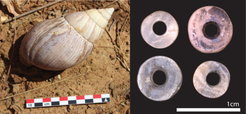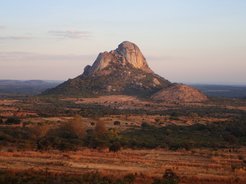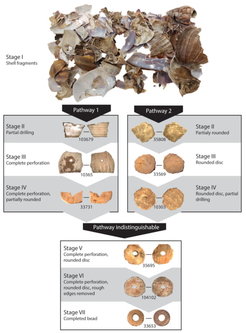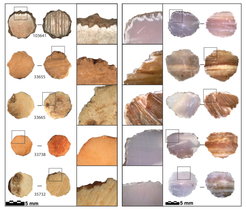Researchers Recreate a 9500-year-old Beadmaking Tradition from Malawi
In a new study, a researcher from the Max Planck Institute for the Science of Human History led a team that re-discovered how ancient people made beads from giant land snails, and found that the origin of this practice is thousands of years older than previously believed.
Today, people wear ornaments (such as beads) to express status, group affiliation, and identity. Throughout human history, our ancestors have worn beads made from a variety of materials, including glass, stone, marine shell and ostrich eggshell. Beads are important archaeological signs of social communication and exchange networks with the power to reveal information about ancient population dynamics.
“These small artifacts often go unstudied,” says lead-author Dr. Jennifer Miller of the Max Planck Institute for the Science of Human History, “but they can actually tell us a lot about ancient societies.”
Now, researchers are combining experimental and archaeological data to study how Stone Age people in Malawi made beads from the shells of giant African land snails, the common name for the species in the Achatinidae family. These medium-to-large snails have shells that commonly reach more than 10 centimeters in length. Although native to Africa, they can now be found on various continents as invasive pests.

Beads made from land snail shells are similar in appearance to those produced from ostrich shell. Both are of similar size (usually less than 1 cm in diameter), with a central perforation and often white or pale coloration. As a result of these similarities, many snail beads are miscategorized, making it a challenge to assess the geographic and temporal range of snail bead use.
But the two materials are not identical. Eggshells and snail shells serve different functions, and their unique microstructures reflect these diverse goals. Ostrich eggs are protective barriers that encase a developing embryo. They can withstand a large amount of pressure from the outside, but are able to be pecked open from the inside when the chick is ready to hatch. Snail shells, on the other hand, are lifelong exoskeletons. Their spiral shaping and internal layer structure make gastropod shells highly resistant to breakage by both internal and external forces. These different shell properties must be considered when reconstructing bead manufacturing sequences, as achieving similar forms may require different techniques or leave distinct traces on each type of shell.
The best way to reconstruct ancient bead production is to find and study incomplete beads, called preforms. These are artifacts that were broken, lost, or otherwise abandoned during bead formation, having never reached the end stage of manufacture. Because beads discarded in early production stages carry the most information, archaeological assemblages with early stage preforms are especially important.

Recent excavations led by Dr Jessica Thompson of Yale University, lead author of the current study, uncovered hundreds of land snail beads and preforms from three sites in Malawi, southern-central Africa. The largest of these collections was recovered from Hora 1, a site renowned for the ancient burial of two individuals who have provided the oldest aDNA sequence in sub-Saharan Africa (8200 years old). The majority of beads and preforms show that beadmaking proceeded by rounding the outer edges first, before drilling the hole, or aperture (Pathway 2). This is the opposite pattern seen in ostrich eggshell beads, which tend to have the aperture drilled first (Pathway 1).
If the aperture is drilled first, as in ostrich eggshell beads, it is easier to string the preforms together and polish them into a single uniform strand. The fact that snail beads were apparently made differently highlights the importance of understanding these different materials on their own terms. Since many of the beads also have a red residue on them, it is also possible that at some point in their manufacture they were intentionally colored using natural red pigments. Alternatively, the red coloration may have rubbed off from the skin of the person making them. These small details offer striking insight into past moments in time.

Two of the archaeological preforms (one each from Hora 1 and Mazinga 1) were directly radiocarbon dated, revealing that people in Malawi were producing land snail beads at least 9,500 years ago. It was previously believed that land snail beadmaking was an Iron Age phenomenon, only occurring after about 4,000 years ago. This new study proves that land snail bead making is rooted firmly in the hunter-forager lifeways of Later Stone Age Africa.
Dr Miller analyzed the archaeological preforms and used them as a guide to replicate ancient bead production. After trying various traditional techniques on modern land snail shells, she found that pressure flaking produced the scalloped edges seen in the archaeological preforms. However, breaking the shells by trampling can also unintentionally produce semi-rounded edges which may resemble early stage preforms, so this requires extra caution. In addition, while all parts of an ostrich shell can be used to make beads, only the body chamber of giant African land snail shells is thick enough for beadmaking. Furthermore, application of natural red pigments to these experimental shells showed that even after being washed, they can still retain this color in the form of a red residue. These differences further emphasize that ostrich eggshell and land snail shell beadmaking must be analyzed in different ways.

This study is an important step towards decoding the symbolic ornaments of ancient people. It sheds light on the mystery of land snail shell beads by providing the first description of snail bead preforms, the only existing experimental replication, and the oldest directly radiocarbon dated preforms. Based on their archaeological and experimental findings, the authors provide a modified production sequence to guide future researchers in the identification and description of land snail preforms. Once there is standardized and systematic reporting of these artifacts, Dr Miller notes, “we can use this information to help us understand how people used the landscape, maintained social networks, and coped with environmental change in the distant past.”



